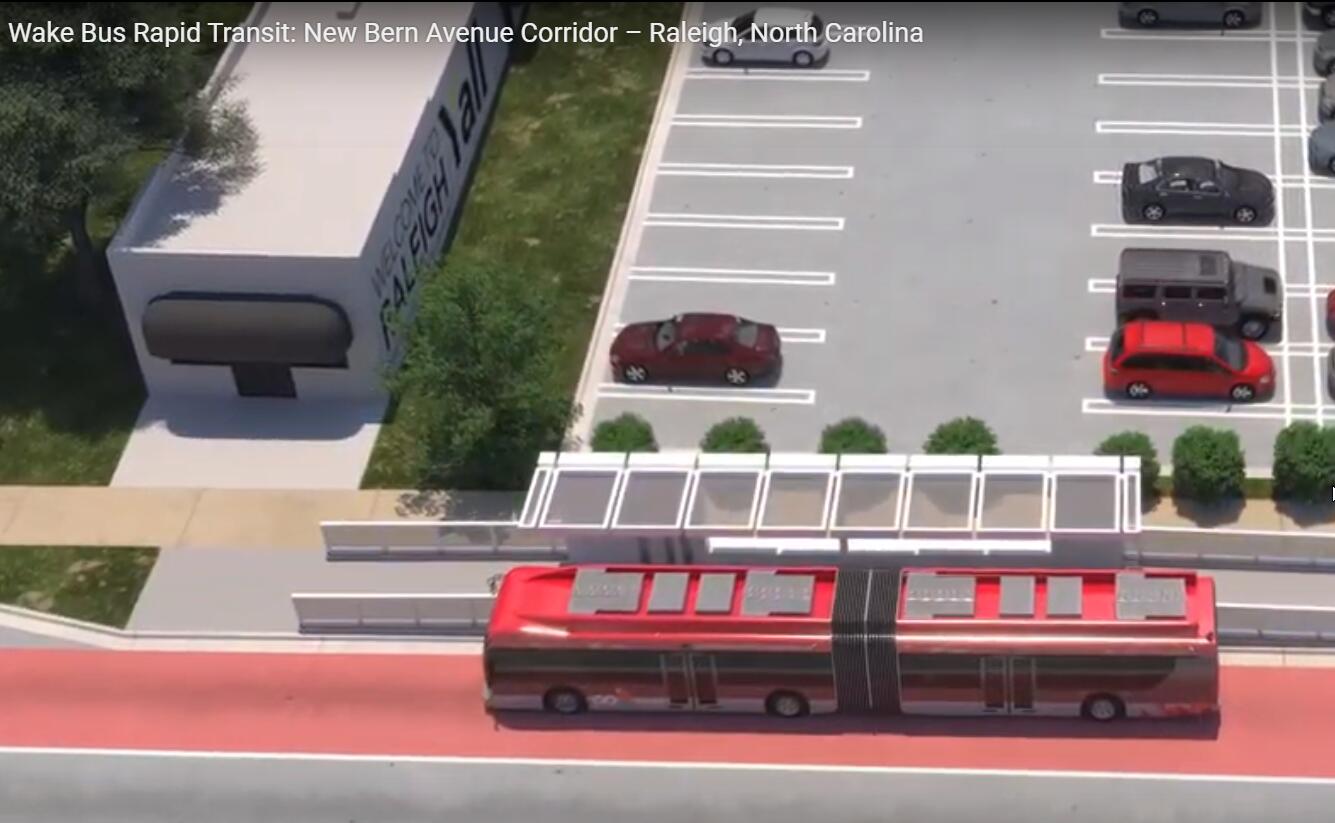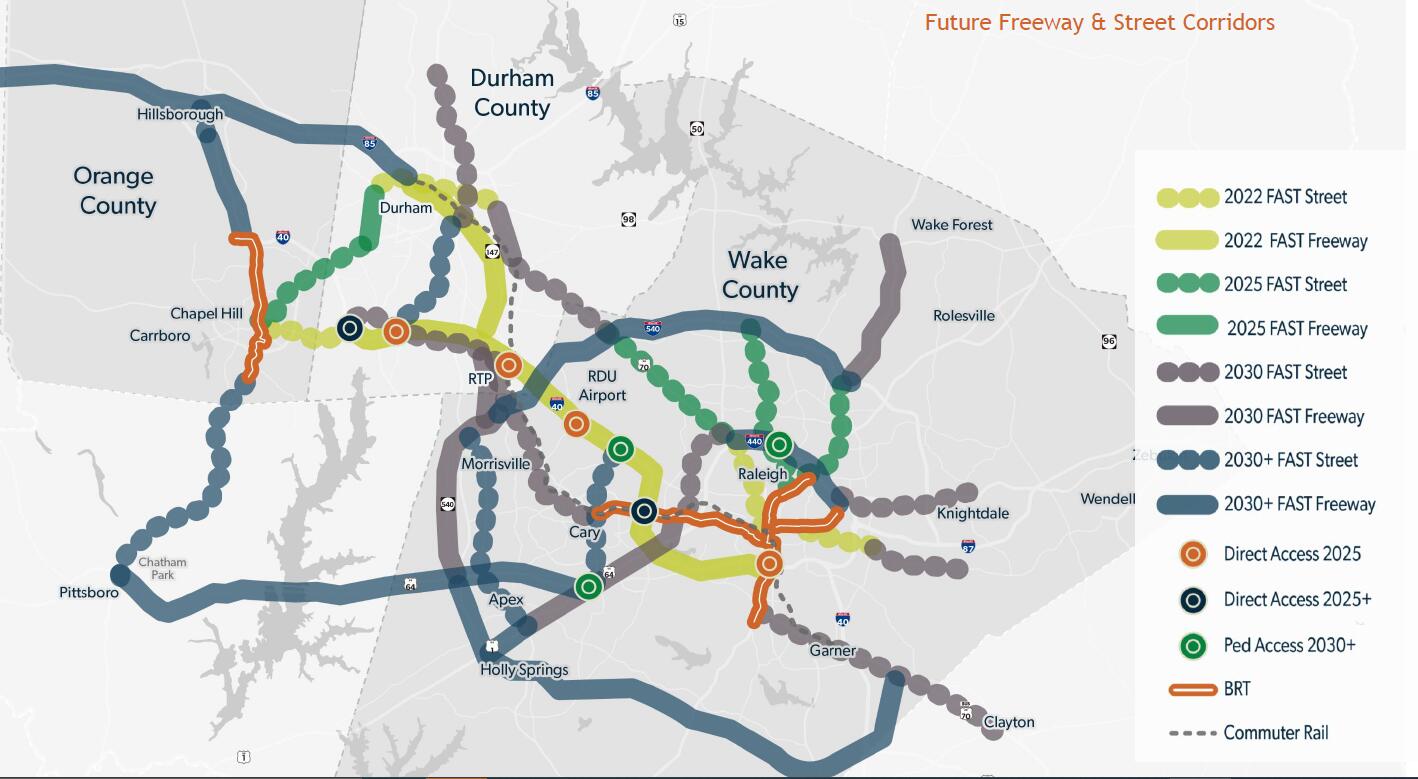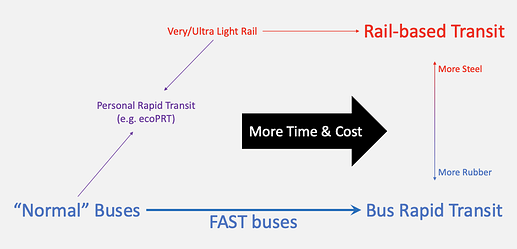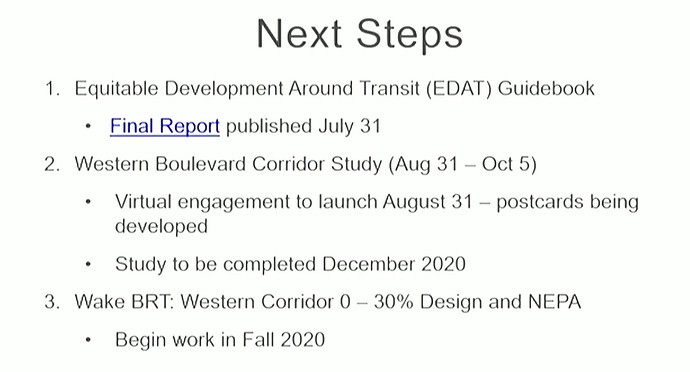Well it’s a bummer the first leg of the BRT project will take 3 or 4 years to be ready.
But it does look really cool. The stations are quite nice. The coolest feature is the raised platform to make level walking into the bus.
Overall these stations look pretty comfortable. Being able to grab one of these rides within 5 minutes (during peak times) is awesome!
Remember that’s still conceptual, though. They still need to come up with shelter designs, so there’s still a chance they will look lamer than that.
(I hope it won’t, but you never know. That’s why I gave my whole spiel about the subcontractors for the next stage of development; how cool/basic the buses, buildings etc. look will depend on Neighboring Architects’ architectural designs and HNTB/PR Pros’ branding ideas)
For BRT I want design that is:
- RIDER CENTERED (absolutely no compromises to rider experience in the name of improving how things look for people driving by in cars)
- Modular - uniform throughout the entire BRT system
- Modern, sleek, attractive
- Economical
I’m kinda surprised I didn’t catch this when it happened, but City Council got through a few key procedural milestones for the BRT projects in the past few weeks!
1. HNTB is officially in charge of making sure BRT both works AND looks well.
Council gave a thumb’s up to HNTB executing the “Wake BRT System Standards” as well finishing where WSP left off on the New Bern BRT design.
The formatting on the city’s PDF copy of the slide deck is broken. But from the City Council meeting recording on June 2, it looks like the City of Raleigh gets the final say on how rider-centric yet sexy the BRT experience will be.
You can watch the actual presentation in the council meeting recording.
2. HNTB is also, now, officially in charge of completing the design for New Bern BRT.
See my previous post on this for details. Except the subcontractors I mentioned before have their feet wet for real, now.
3. WSP will start figuring out the details for the Western Blvd. and southern corridors.
The original plan in the 2016 referendum was to have WSP work on the basic design of all 4 BRT lines at once. But especially after the Durham light rail dumpster fire, our strategy now is to make sure New Bern gets through the project pipeline first.
…and, should things go wrong, let New Bern take the hit, and make sure we learn from its mistakes for the other three lines (rather than doing it all at once, and putting the whole BRT system at risk of crashing and burning from one screwup).
Now that WSP’s job for the New Bern line is complete, the city gave them a green light to figure out the Locally Preferred Alternative for the next two lines. Thanks to this contract:
This means, with the help of GoTriangle, NCDOT, city departments etc., GoRaleigh and WSP will:
- figure out if BRT should run along Wilmington St. or McDowell St.
- how should BRT approach Garner
- how should BRT route itself west of the Hillsborough/Western intersection
- how would these BRT routes run downtown and connect with the New Bern service
- learn about big-picture traffic trends/needs/challenges along the corridors
- figure out if either of the routes stand a chance at getting federal funding help
They will not do things like:
- figure out how to lay out lanes within every inch of the BRT corridor, including sidewalks, bikeways, and greenways
- do more detailed traffic analyses (e.g. to see if BRT could make traffic worse)
- do environmental analyses (i.e. who or what could the BRT projects be harming or destroying?)
…unless they opt to make another, separate contract amendment for “0-30% design” this Fall.
What about Capital Blvd.?
The northern line’s still scheduled to be on ice until this fall.
I’m not sure if this was a budget thing or they knew this from the start, but I think it was a smart move to wait to start planning this leg of the BRT system. The
New plans for the midtown/St. Albans area are set to come before the Council this July, and they include suggestions for BRT spur lines. Plus there’s the really-cool-lookin’ Capital Blvd. North corridor study which is implied to be adopted sometime this year, though I’m having a hard time finding a specific timeline.
Wait, are there two different companies doing almost the exact same things?
Surprise, surprise: GoRaleigh board members were also confused and had the same exact question.
WSP reps conceded on their procedural screwup and apologized to chairwoman Omokaiye about this, and committed to making sure they work with HNTB to have a smooth public outreach campaign so the public doesn’t have the same confusion/problems.
The FAST study preliminary findings are released.
https://www.letsgetmoving.org/priorities/fast-network-study/
It seems that, within Raleigh, the priorities are:
(1) I-40 - but it’s not clear what is planned beyond the already-existing BOSS program
(2) Glenwood Avenue ITB
(3) Poole Rd
Following behind is:
(1) Glenwood Ave OTB
(2) Six Forks
(3) Capital Blvd OTB
I must say I am a bit confused with difference between this “FAST” thing and BRT. Is FAST basically BRT light?
A bit confused myself but I looked it up, since the graphic refers to both BRT and FAST. FAST: a Freeway And Street-based Transit network vision for the Triangle, including a 2025 FAST network concept and potential SuperFAST projects that could be implemented even more quickly.
The slide deck mentions it if you read the whole thing:
The point of FAST, from how I read it, is that it’s supposed to upgrade existing bus services, rather than replacing them with something on the same corridor (like how the New Bern Ave. BRT will basically replace GoRaleigh Route 15).
Doing FAST means making investments like running more frequent buses, BOSS service (running buses on interstate shoulders), and lanes and stoplights that give priority to buses. I think a better way is to think of it as a way to make “normal” buses look and work more like BRT:
A locally preferred alternative for the Western Blvd corridor appears to be on the agenda for next Thursday’s Raleigh Transit Authority meeting.
Edit: updated link.
So is FAST going to be stops/bus lanes on the Freeway or just using them bus lanes on the freeway en route to off-freeway stops/destinations? Because if it’s the former, I’m not sure how effective that would be
It’s both. FAST stands for a Freeway And Street-based Transit, so the whole idea is to run buses on both highways and major streets (plus BRT right-of-ways, too, 'cuz why not?).
But, this study is about defining and justifying FAST “corridors”, or broad-stroke paths in the Triangle. RTA needs to convince its members and stakeholders that the idea of FAST buses plus these specific corridors are worth taking seriously. This preliminary report is not about how buses will specifically operate in those corridors, since everyone has to agree on my previous sentence before you do that. In other words, when they say:
…they mean you might want to think of this as an infrastructure project -not a route-planning exercise.
By the way, you can finally read the actual report now!
For example...
Poole Rd. is listed as one of the roads that could benefit the most from getting FAST-related upgrades ASAP.
Remember that they’re not done with the entire study, though.
According to the report...
For the Poole Rd. example, this means we still need answers for questions like:
-
Which intersections get those bus-only queue-skipping lanes (and other upgrades)?
-
How much would those upgrades cost? Who’s paying for them? Is GoTriangle, GoRaleigh, or someone else responsible for running this thing?
-
What is the human and natural environment along Poole Rd. like, beyond what the RTA has found, so far? What values, benefits, and obstacles are around here? This is a predominantly-Black, historically disadvantaged and ignored community, so you really shouldn’t shove your ideals down residents’ throats, around here.
-
Can those upgrades be built together with other upcoming construction projects like express lanes for I-40?
-
Where should the upgraded bus stops be built? …or are these “stations”??
-
What’s the best route for buses that will run through this corridor? Should these buses only run on parts of the New Bern BRT route towards Moore Sq., or also extend out to places like Dix Park or Capital Blvd.?
Some of these issues may be answered by the completed FAST study (whenever that happens…), but you still have to study and answer more questions (and get more people on board with the idea!) before FAST buses can become a thing. This preliminary study helps us figure out just what those questions really are.
Gotcha! Thanks for the explanation. I figured this was probably a very high-level, not in the weeds study so I’ll await further answers to my questions 
Got some screenshots from the meeting… they’re not great, but you get the idea. Looks like they’ll be extending Western Blvd to connect to Cary Towne Blvd. The route will then run north up Maynard, then west on Chatham to terminate at Cary Deport. Town of Cary signed off on this in late July. Presenter noted that, while this “zig-zag” pattern is the longest option, it is only expected to add one to two minutes to the full travel time. Rationale is that this route will pass through more transit-dependent populations than the more direct routes that were being considered.
Honestly, I felt really uncomfortable after watching bits and pieces of that presentation.
Even on paper, this LPA (the route we tell the FTA is the best we got for a project) is really difficult to justify with only the slides we saw here. Lots of basic questions weren’t even given the time of the day in the presentation, such as what the cost and benefits of the LPA are compared to the other routes are.
Then the presentation actually happened, and the GoRaleigh planner managing BRT planning/design gave rambling answers and misinterpreted a handful of questions from the GoRaleigh board.
Sure, this isn’t the first time GoRaleigh chairwoman Omokaiye felt pressured to hurry along with their approval as if City Council doesn’t care about GoRaleigh leadership doing its job as Project Sponsor. Even then, it was painfully clear that wasn’t why she was rolling her eyes at the staffer’s confused non-answers.
I have watched the preso now, and I see what you’re saying about the GoRaleigh rep giving confused non-answers. Nevertheless, I still feel this is the right decision.
- Fitting BRT on the straight-line route of Hillsborough - East Chatham isn’t as easy as it would seem. The exisitng street is inside the NCRR right-of-way, and NCRR is demanding that any construction should go outside of that right-of-way. Doing so might be basically just as expensive as building the Western Blvd connection. Particularly in Raleigh, they’d have to acquire heaps of property to make it possible. They could conceivably even demand that the bridge over I-40 be torn down and moved south.
- Being closer to current transit-dependent populations is definitely true. Lots of inexpensive apartments along Buck Jones that would be right next to the Western Blvd extension.
- Connects to all the potential urban development nodes (Chatham Square, Cary Town Center, Fenton)
- If BRT lives and dies by absolute running time from downtown Cary to downtown Raleigh, then what’s the point of Commuter Rail? Let commuter rail handle the bulk of end-to-end traffic in this corridor. BRT should be about connecting the people and destinations between.
It was a very uncomfortable presentation. I kind of got the impression that they don’t really value the input of RTA, just their approval. They should have at least had time to look it over prior to the presentation. And the presenter should have been prepared to get drilled with questions… and she wasn’t.
I do agree with @orulz, though. I think the routing makes sense, and I’m guessing it’s still going to be faster end-to-end than the current 300 route by nature of it being BRT. The straight-shot will come with commuter rail. Another thing that the presenter mentioned several times was that most of the ROW was already complete for the Western Blvd extension, and ROW tends to be one of the most difficult aspects of these types of projects.
Ultimately, this routing selection has a much greater impact on Cary than Raleigh (as a majority of the Raleigh routing was already set in stone by being on Western Blvd), and the Cary Town Council voted unanimously for this thing, so I guess that works for me.
I definitely like the pro’s of the Cary Towne/Maynard alignment (especially having a bigger catchment area and being able to build on both sides of the roads), and the fact you’d be able to directly service where Cary Towne Center is now is absolutely a good thing. Assuming this BRT line gets built and runs just fine, I agree with y’all, and I think the LPA will work out awesomely.
My concern is if it doesn’t, and City Council, the media, NIMBYs etc. scapegoat GoRaleigh. As the project sponsor, the city agency with skin in the game, they wouldn’t be able to punch back since they approved the proposal. I’m probably being a stickler for parliamentary procedure and clear answers here, but I just hope this decision to not deny the LPA won’t come back to haunt the BRTs we deserve.
'cuz… y’know. The last thing we need is for Raleigh to repeat Durham’s mistakes in light rail – especially if that also hurts other projects (like extending Capital Blvd. BRT to Midtown Exchange or North Hills) down the line.
I worked on this years ago when the development across from Cary Towne Center was coming in for rezoning and at the time Chatham was the planned route. But as some of you have already mentioned, the railroad really hems in the potential for that route. So we proposed putting the BRT line down Western - Cary Towne - Walnut and into downtown Cary. I guess after I left the Town got skittish about having it go up Walnut even though that would go by some of the major investments on South Academy, probably due to anticipated push back from those that live on in neighborhoods along that one stretch of Walnut.
I’ve heard that the Town has really botched public outreach to the Latino community living primarily in the mobile home parks that it will pass. I hope they’ve since done a better job but the ToC’s approach seemed pretty poor. That said, I think that LPA can work and can open up some good potential for redevelopment in both municipalities.
Wait a minute - The Town of Cary has a mobile home park? That does not fit with their prim and proper suburbia image.








